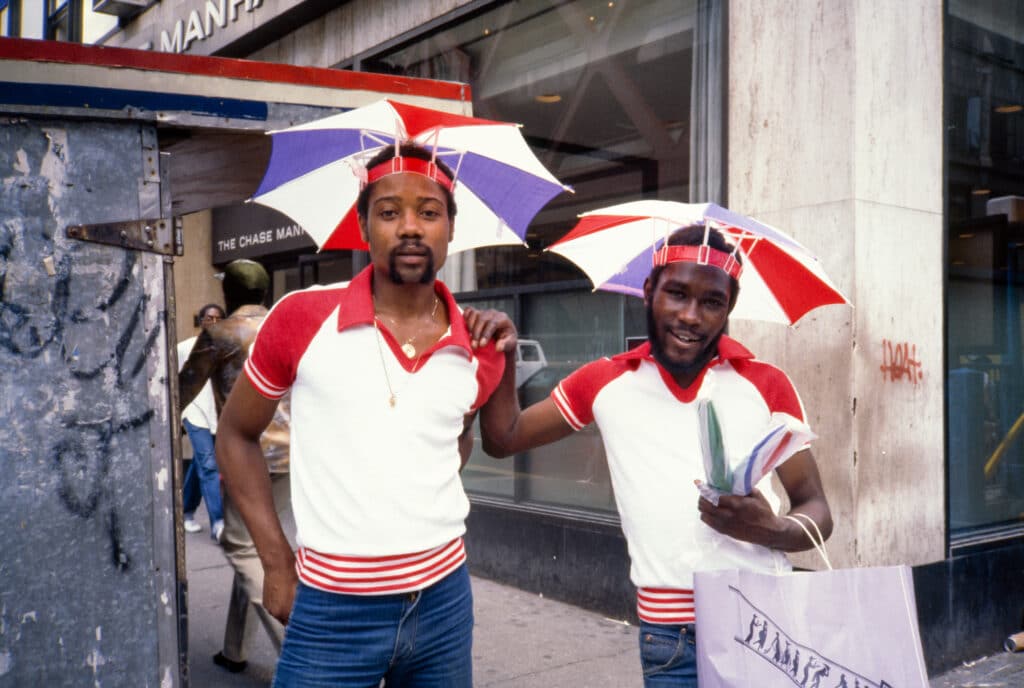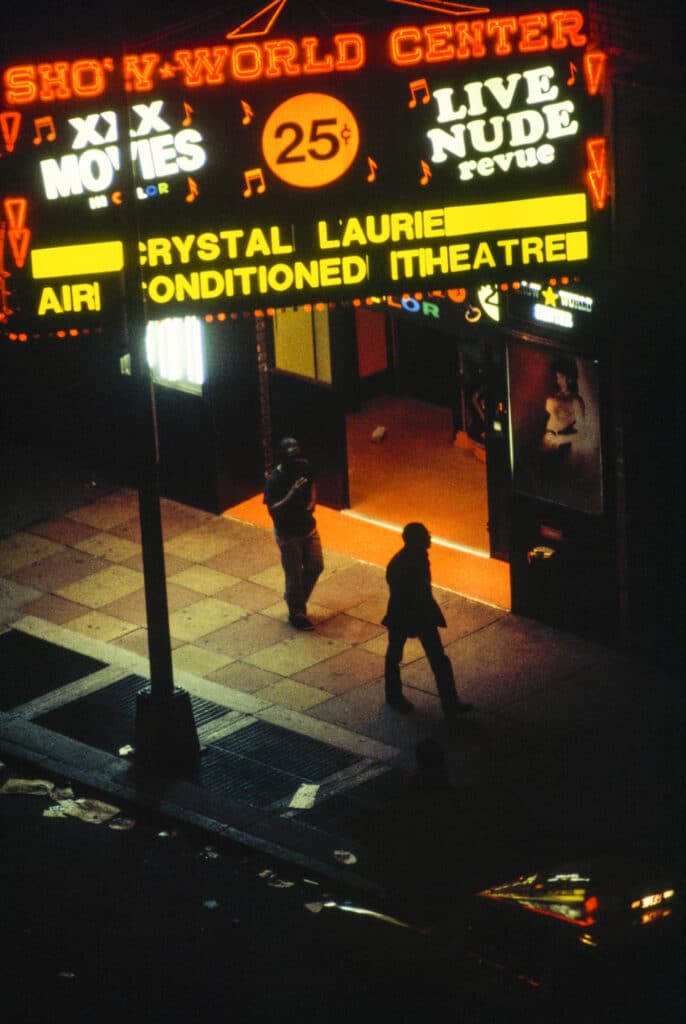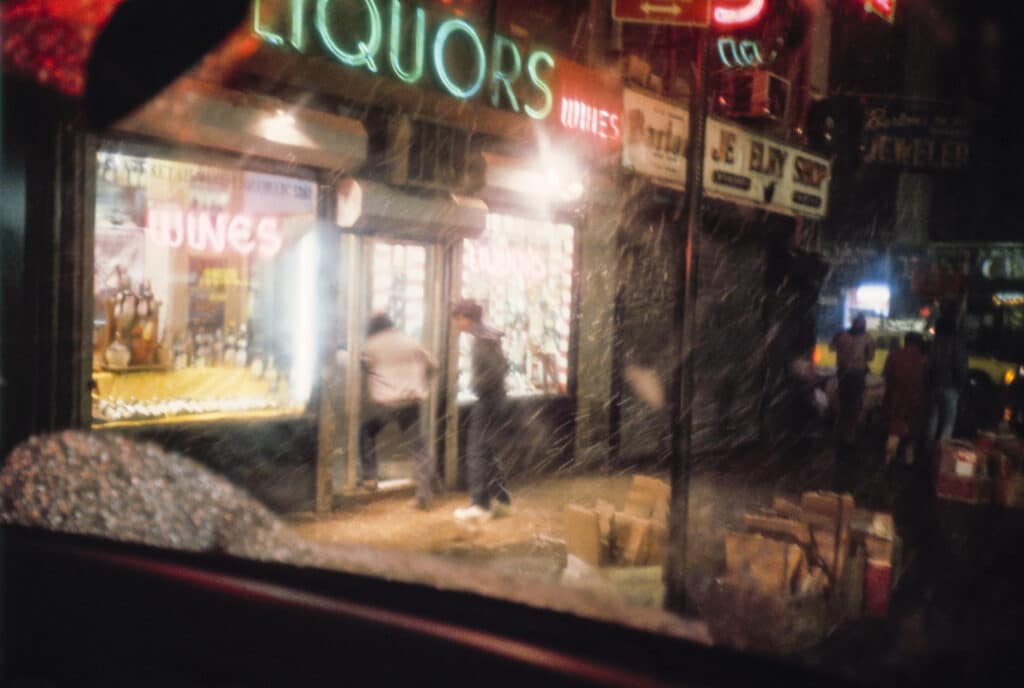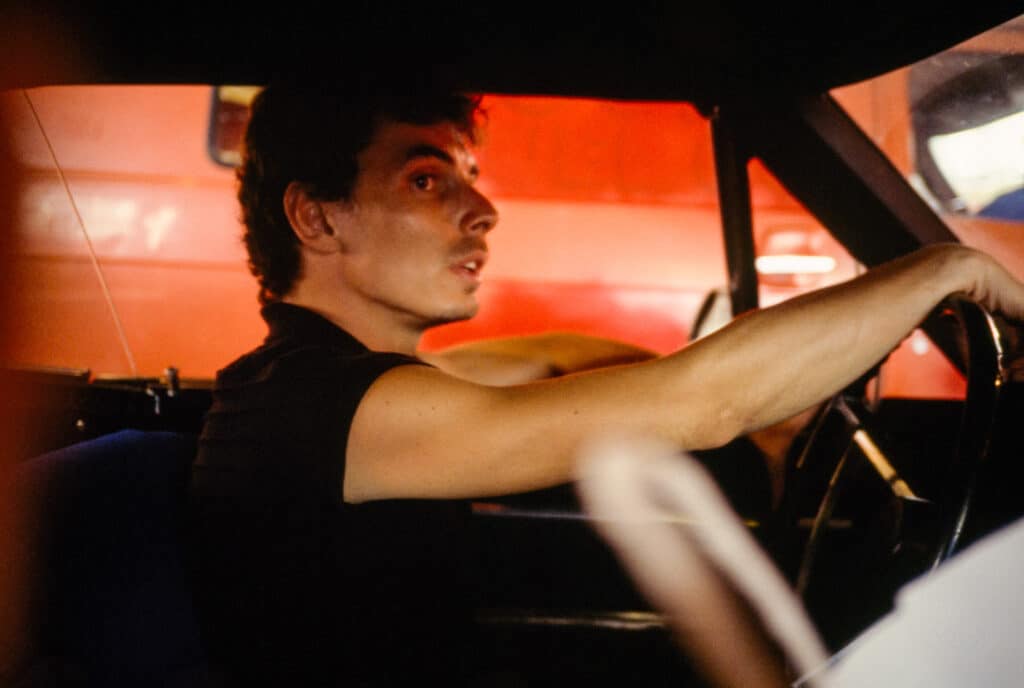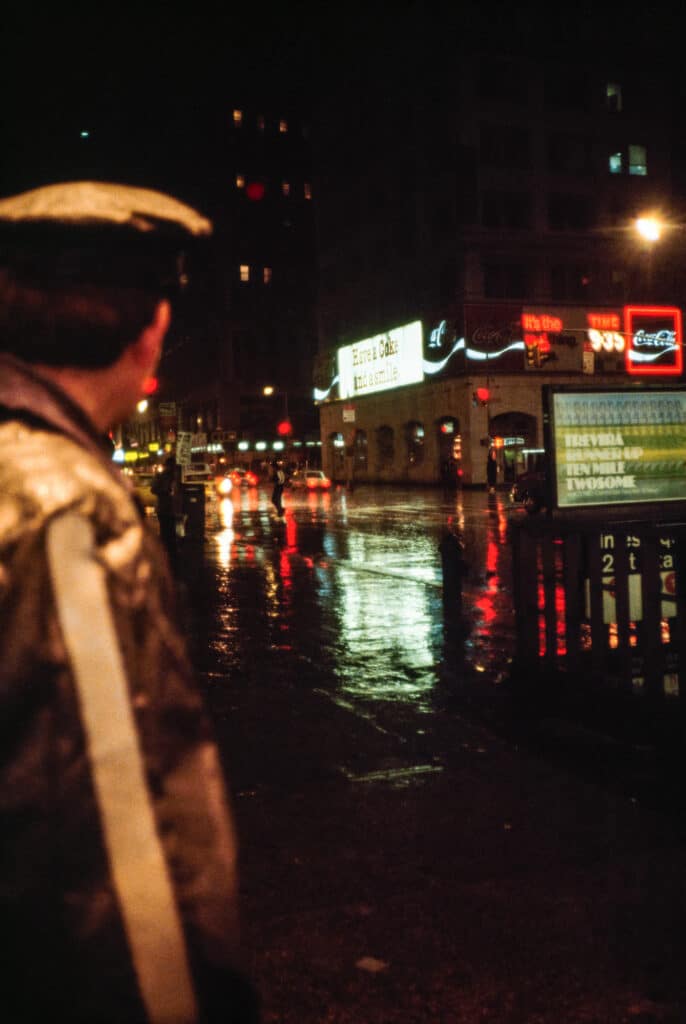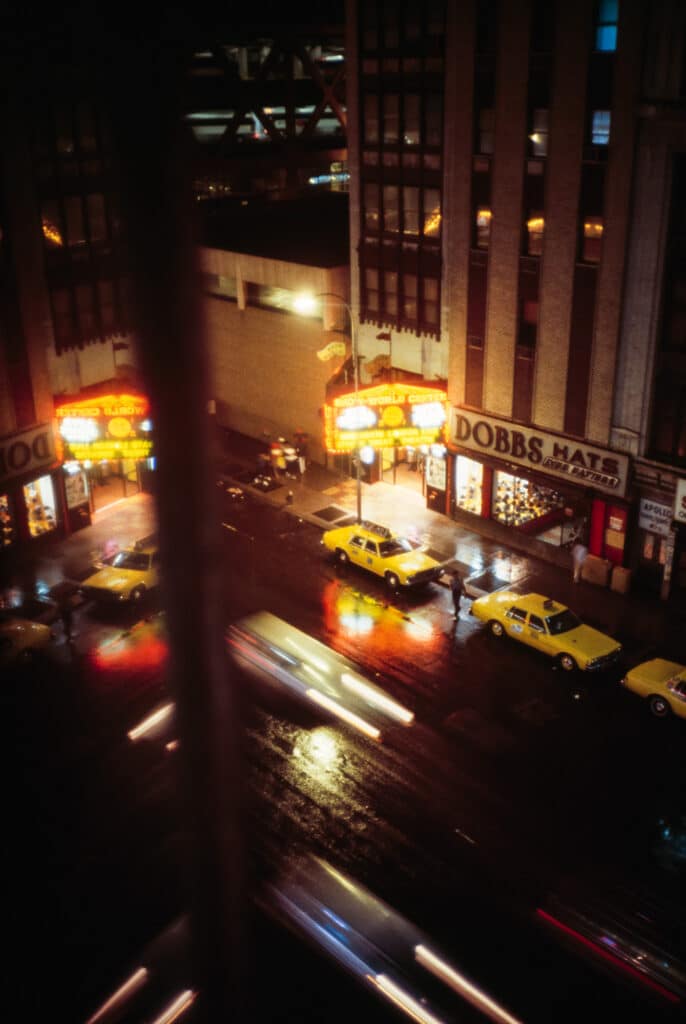Although it has always been a hotbed for decadence and debauchery, Times Square maintained a semblance of culture and panache until mid-century, when the Great White Way began a slow but steady descent into the clutches of the bas monde. By the 1970s, pornographers, sex workers, drug dealers, grifters, thieves, runaways, and sundry derelicts had transformed Times Square into the red light capital of the eastern seaboard. Day and night, pimps and hustlers peddled pleasures of the flesh on the street while those who preferred indoor activities could pay to play at local brothels, XXX theaters, strip clubs, sex shops, and massage parlors.
As Broadway’s glitter turned to grit, artist Jane Dickson was fascinated by the world in which she lived and worked from 1978–2008. An aspiring painter, Dickson came to New York knowing she needed a day job — and as fate would have it, she secured a gig working as an animation designer operating the first computer lightboard at the Spectacolor Billboard at One Times Square. She began carrying a camera to record impressions of the spectacles she encountered on the streets, which became the basis for an ongoing series of work — selections of which are now on view at the “Whitney Biennial: Quiet As It’s Kept.”
Sweet Jane
Jane Dickson’s arrival in New York was emblematic of things to come. As she drove under the derelict West Side Highway to her Tribeca loft, she remembers, “I was passing this weedy vacant lot, heard the sound of a car horn blaring, and saw flames. Someone had stolen a car, stripped the tires and battery, and set the car on fire. The flames hit the horn and it was like the dying cry of this car just wailing. It was late afternoon, and the smoke and flames were set against the sunset over New Jersey, and I thought, ‘Oh my God, I’m moving into Hell.’”
The following year Dickson moved into filmmaker Charlie Ahearn’s small loft on Fulton Street. They shared a bathroom with then-unknown artist Cindy Sherman, who lived across the hall, and spent time down at South Street Seaport, when it was the favored haunt of old seamen. “It was the end of the previous era, an ancient world,” Dickson says. “The city was bankrupt and all the powers that be had given up and moved out to the suburbs. The police didn’t care and you could do whatever you wanted. Charlie was making a film and did a scene where a little kid shot graffiti on a cop car at One Police Plaza. The cops walked by and laughed. They didn’t care. It was just nuts.”
Dickson reveled in the freedom of New York life, quickly discovering the law of the land: if you want something done, you’ve got to do it yourself. After high-school friend turned Magnum Photos member Alex Webb showed her a carousel of photos, Dickson had an epiphany. “I realized you don’t just wait for that one perfect shot that’s going to be the cover of the New York Times Magazine,” she says. “I realized he takes a million photos and out of those, there are a few great ones. I decided to get a Lumix camera that I could carry around New York. My eyes and mouth were wide open.”
Beginning to See the Light
Although Jane Dickson was only paying 90 dollars a month for her half of the rent, she knew she needed a better job than the one she had. While looking through the paper, she happened upon a help wanted ad looking for an artist willing to learn computers to work the first digital lightboard at One Times Square — the original New York Times building where the New Year’s Eve ball drops.
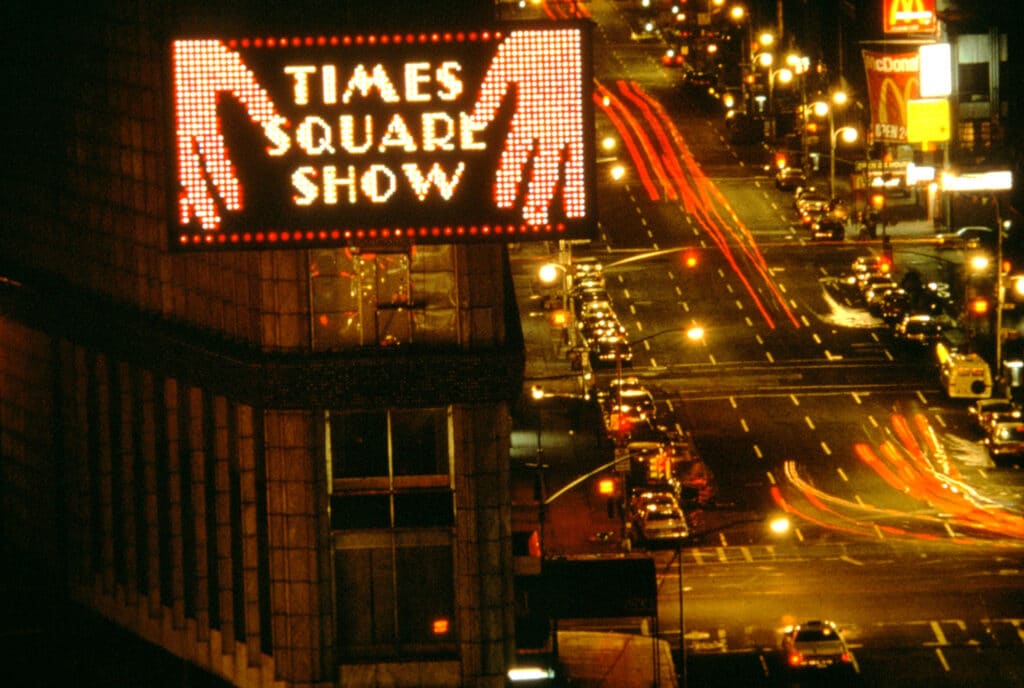
Dickson got the job and began designing digital ads for clients like Coca Cola, Colgate, and the Andy Warhol film Dracula, as well as public service announcements, which were required by law. She discussed doing art projects with her boss. As a member of the downtown artist collective Colab (Collaborative Projects), Dickson was involved with guerilla art projects like the fabled Times Square Show, which opened in June 1980 at an abandoned massage parlor on the corner of 42nd Street and Eighth Avenue.
“I went to [artist and writer] Walter Robinson to try to raise money for the show and he said, ‘We’re going to talk to the Public Art Fund,’” Dickson says. “I told Jenny Dixon, who was running it at that time, that I had programmed the computer billboard to run an ad every 20 minutes for the whole month and told Jenny, who said that if I could get access to the sign, she could get money to do an artist series.”
The series, “Messages to the Public”, ran from 1982–1990, with Dickson kicking things off, introducing a new generation of groundbreaking young artists to the general public. Every month, works by artists including Jenny Holzer, Keith Haring, David Hammons, and CRASH lit up the sky — but even in Times Square, some artists proved to be too incendiary. Dickson recalls, “Both Barbara Kruger and Nancy Spero did women’s right to choose pieces, which was censored because Jane’s boss was a devout Catholic.”
I’ll Be Your Mirror
After working the weekend night shift at the Spectacolor Billboard, Jane Dickson got off work around midnight — the perfect time to hit the clubs. One night in 1981, Charlie Ahearn picked her up. Walking past Studio 54, he said, “Wouldn’t it be cool to live here?”
As it turned out, Ahearn had spotted a building on 43rd Street advertising lofts for rent and Dickson thought it would be a good idea to get a larger space. “Charlie had just started making Wild Style in the Fulton Street loft, which was a studio apartment. I couldn’t live there while he was making a movie and have a film production in our bedroom,” she says.
They went over to check out the loft one afternoon. “Three quarters of the building was empty because it had already been zoned for redevelopment,” Dickson says. “I don’t know what it had been before but at this point it was supposed to be used by theater groups. You would be in the elevator and these acting students would do this incredible flourish when they pressed the button then look around like you should applaud.”
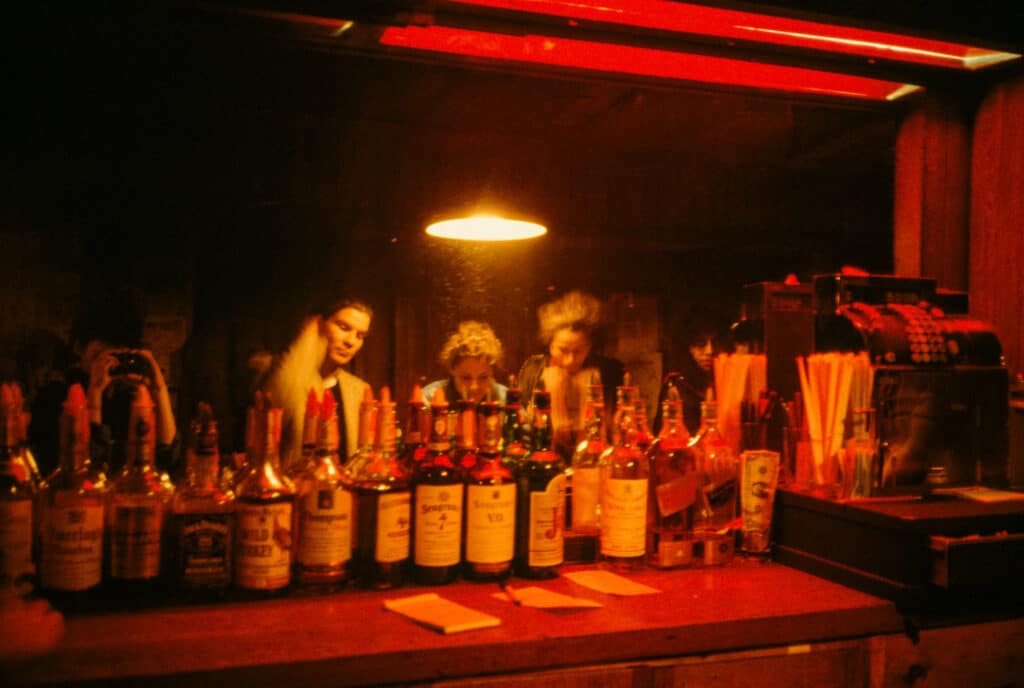
Living in Times Square during the 1980s inspired Dickson to focus her painting process on scenes of daily life, offering a woman’s perspective on street and strip club culture, which were dominated by men. “I wanted to be a witness to my time and to record my experience with the idea that women’s views have not been well acknowledged,” she says. “At first I tried to sketch things to make a painting, but my sketches didn’t have much detail so I started taking pictures from the window of my loft and my office at One Times Square.”
By the 1970s, photography had infiltrated painting after artists like Andy Warhol openly incorporated it into their work. But the rise of photorealism and its attendant focus on the mundane didn’t intrigue Dickson; she looked to the work of artists like Francisco Goya, William Hogarth, and Honoré Daumier who used painting as a tool of social justice and critique.
Walk on the Wild Side
“I thought that if I have my camera, I can document what strikes me as significant to record and portray,” says Jane Dickson. “I also carried my camera on the streets so that if something happened I could take a picture of it. The camera helped me feel like an observer and it made me feel brave. I had a mission and would go into all kinds of crazy places and take pictures. I did a lot of shooting from my hip because I didn’t want people to see me taking pictures or I’d get beat up.”
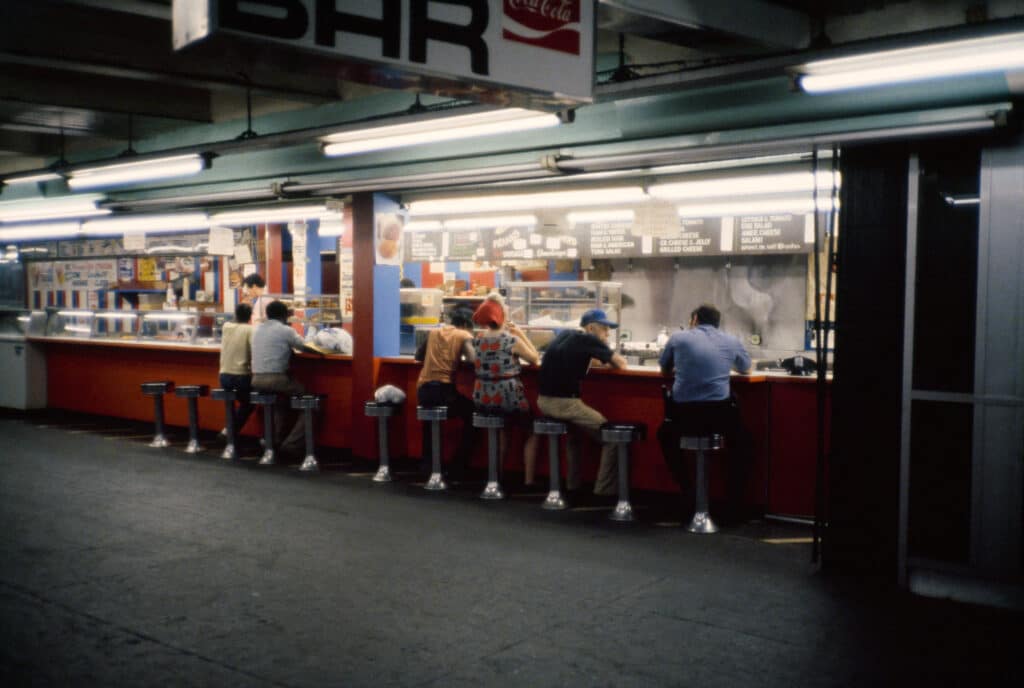
As Charlie Ahearn began ramping up for the production of Wild Style, Dickson decided to get a studio on 42nd Street between Seventh and Eighth. “It was a really heavy block – solid runaways, pimps, and junkies. My studio was located in a building that had been a blood bank before the city had to close them because of AIDS,” she says.
But while the landlord was renting lofts to artists, the building superintendent had plans of his own. “The super rented out the lobby to drug dealers and the stairwells were for shooting up,” says Dickson. “Every time I walked in or out of the lobby, these guys with dead eyes would say, ‘Coke, speedball, coke, speedball.’ I said ‘No, thank you’ politely 100 times but they were high as kites. I assumed they would knife me if I sneezed.”
After having her first child, Dickson abandoned her 42nd Street studio in search of a safer space — only for her home to be flooded after junkies broke into a loft on a higher floor and busted a water pipe. Dickson went up to see the loft that was causing problems and was shocked at what she found. “It was so beautiful!” she remembers. “Our living loft had been a clinic and there were lots of little examining rooms. But this loft was just open because it had been used as a theater rehearsal place, so I decided whenever we could get the water turned off, I’d use it as a studio.”
Now able to commute by elevator with her baby in tow, Dickson felt a sense of relief. “After my son was born I thought, ‘I need to be careful with my life because this little person depends on me,’” she says. “We had already had somebody shoot through the window — twice. Someone else dropped a full can of soda from a high floor of the Carter Hotel while I was walking down the street. It brushed my arm and exploded on the sidewalk. If that had actually hit my shoulder I’d never be able to use my arm again.”
Requiem for a Dream
Looking back at the era that has continued to fuel her work, Jane Dickson sees it as a potent time before everything became professionalized and corporatized. “This was the last gasp of an optimistic feeling that went through America from the post war through the 1970, when people could just do anything they wanted. You could start a gallery or a magazine, or get a studio for 100 dollars a month. If you wanted to start a coffee shop, you didn’t have to contend with Starbucks,” she says. “Yes, we were in a downturn, but everything seemed possible.”
Jane Dickson’s work is on view in “Whitney Biennial: Quiet As It’s Kept” through September 5, 2022 at the Whitney Museum of American Art in New York.
